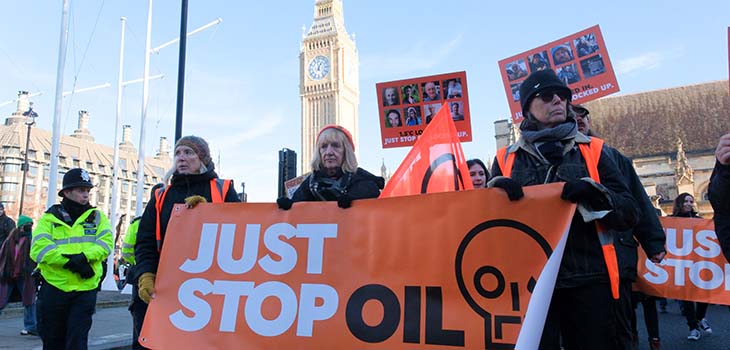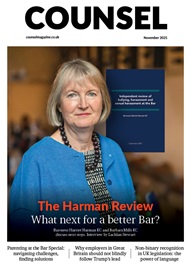*/

Will the Public Order Bill actually achieve the government’s aims? And do the police want these broad new pre-emptive powers anyway? Zoë Chapman considers the efficacy of the Bill and its latest amendments
If at first you don’t (fully) succeed, try, try again. The Public Order Bill is currently in the final stages of debate, having been introduced soon after the heavily criticised Police, Crime, Sentencing and Courts Act 2022 (PCSCA 2022) received Royal Assent on 28 April 2022.
This new Bill represents the government’s second bite at the anti-protest cherry, seeking as it does to reintroduce various measures that were originally in the PCSCA 2022 but which were defeated in the House of Lords: new offences of locking on, being equipped to lock on, interference with major transport works and interference of key national infrastructure; the expansion of stop and search powers in relation to protest; and Serious Disruption Prevention Orders – otherwise known as protest banning orders – which could be issued even if no offence has been committed and may impose a prohibition on entering certain areas, meeting certain people, or using the internet, and could even involve electronic tagging. ‘Serious Disruption’ is the common justification for these new measures, the phrase appearing 132 times in the current version of the Bill.
On 16 January 2023, the Prime Minister announced that a late amendment to the Bill would be tabled, designed to broaden the definition of ‘serious disruption’ so that (for example) ‘police will not need to wait for disruption to take place and can shut protests down before chaos erupts’ . The House of Lords has removed government amendments that would allow police to pre-emptively restrict protests and to stop and search protesters without suspicion, and would give courts the power to impose protest banning orders on individuals who have not been convicted of a crime. However, the Commons can still reverse many of the second and third of those amendments, along with the majority of others.
The ‘fact sheet’ accompanying the government’s Bill is littered with polarising language: ‘disruptive and dangerous’ and ‘guerrilla tactics’ versus ‘the hardworking majority seeking to go about their everyday lives’, ‘taxpayers’. There is a brief reference to the right to protest by way of an assertion that the Bill is intended to ensure the police can ‘better balance the rights of protesters against the rights of others to go about their daily business’, but the intimation is that the balance at present is weighed (unfairly) in favour of protesters. The elephant lurking among all this ‘them and us’ rhetoric is the absence of any acknowledgment of the potential legitimacy of protesters’ motives, or of the fundamental function of protest in the sort of democratic society we may hope to live in one day.
The government claims to have its sights trained on a discrete ‘minority’ it brands as ‘extreme’ and ‘criminal’ (Just Stop Oil, Insulate Britain and Extinction Rebellion are specifically referred to in the fact sheet). But the provisions in this Bill are not specific, tailored. On the contrary, they are extremely broad, and would clearly encompass a wide range of otherwise everyday behaviour – from carrying a bike lock around with you, to exercising your fundamental human right to peacefully express your disapproval of a government policy.
Would this Bill achieve its purported aim? Would the measures in this Bill actually deter someone desperate to avert a looming climate catastrophe, for example? It is hard to believe that the authors of this Bill genuinely believe their own rhetoric in this respect. Nor does it seem that the police necessarily want additional powers to deal with disruptive protesters. Speaking at the time of the PM’s announcement on 16 January, Met Commissioner Sir Mark Rowley said that he and other police chiefs ‘have asked for legal clarity about where the balance of rights should be struck’ rather than ‘new powers’.
This comment follows the recent Ziegler judgment, in which the Supreme Court held that exercising the right to protest could constitute a ’lawful excuse’, even where the interference with others’ rights is more than minimal, and a High Court ruling that the Met breached the rights of the organisers of a planned vigil for Sarah Everard. The Met’s response in the former case was to issue a statement that the ruling did not represent a significant change in the law and that ‘If there’s a wilful obstruction, which is unreasonable, and it’s extended [in] impact, then of course, I think there’ll be an expectation that police take action’ . Following the latter, Scotland Yard announced that it was considering an appeal as the judgment had ‘potential implications in other circumstances for how a proportionality assessment is to be carried out when considering enforcement action’.
These responses suggest that training and operational clarity, rather than increased powers in the hands of ever more junior officers, is the answer.

If at first you don’t (fully) succeed, try, try again. The Public Order Bill is currently in the final stages of debate, having been introduced soon after the heavily criticised Police, Crime, Sentencing and Courts Act 2022 (PCSCA 2022) received Royal Assent on 28 April 2022.
This new Bill represents the government’s second bite at the anti-protest cherry, seeking as it does to reintroduce various measures that were originally in the PCSCA 2022 but which were defeated in the House of Lords: new offences of locking on, being equipped to lock on, interference with major transport works and interference of key national infrastructure; the expansion of stop and search powers in relation to protest; and Serious Disruption Prevention Orders – otherwise known as protest banning orders – which could be issued even if no offence has been committed and may impose a prohibition on entering certain areas, meeting certain people, or using the internet, and could even involve electronic tagging. ‘Serious Disruption’ is the common justification for these new measures, the phrase appearing 132 times in the current version of the Bill.
On 16 January 2023, the Prime Minister announced that a late amendment to the Bill would be tabled, designed to broaden the definition of ‘serious disruption’ so that (for example) ‘police will not need to wait for disruption to take place and can shut protests down before chaos erupts’ . The House of Lords has removed government amendments that would allow police to pre-emptively restrict protests and to stop and search protesters without suspicion, and would give courts the power to impose protest banning orders on individuals who have not been convicted of a crime. However, the Commons can still reverse many of the second and third of those amendments, along with the majority of others.
The ‘fact sheet’ accompanying the government’s Bill is littered with polarising language: ‘disruptive and dangerous’ and ‘guerrilla tactics’ versus ‘the hardworking majority seeking to go about their everyday lives’, ‘taxpayers’. There is a brief reference to the right to protest by way of an assertion that the Bill is intended to ensure the police can ‘better balance the rights of protesters against the rights of others to go about their daily business’, but the intimation is that the balance at present is weighed (unfairly) in favour of protesters. The elephant lurking among all this ‘them and us’ rhetoric is the absence of any acknowledgment of the potential legitimacy of protesters’ motives, or of the fundamental function of protest in the sort of democratic society we may hope to live in one day.
The government claims to have its sights trained on a discrete ‘minority’ it brands as ‘extreme’ and ‘criminal’ (Just Stop Oil, Insulate Britain and Extinction Rebellion are specifically referred to in the fact sheet). But the provisions in this Bill are not specific, tailored. On the contrary, they are extremely broad, and would clearly encompass a wide range of otherwise everyday behaviour – from carrying a bike lock around with you, to exercising your fundamental human right to peacefully express your disapproval of a government policy.
Would this Bill achieve its purported aim? Would the measures in this Bill actually deter someone desperate to avert a looming climate catastrophe, for example? It is hard to believe that the authors of this Bill genuinely believe their own rhetoric in this respect. Nor does it seem that the police necessarily want additional powers to deal with disruptive protesters. Speaking at the time of the PM’s announcement on 16 January, Met Commissioner Sir Mark Rowley said that he and other police chiefs ‘have asked for legal clarity about where the balance of rights should be struck’ rather than ‘new powers’.
This comment follows the recent Ziegler judgment, in which the Supreme Court held that exercising the right to protest could constitute a ’lawful excuse’, even where the interference with others’ rights is more than minimal, and a High Court ruling that the Met breached the rights of the organisers of a planned vigil for Sarah Everard. The Met’s response in the former case was to issue a statement that the ruling did not represent a significant change in the law and that ‘If there’s a wilful obstruction, which is unreasonable, and it’s extended [in] impact, then of course, I think there’ll be an expectation that police take action’ . Following the latter, Scotland Yard announced that it was considering an appeal as the judgment had ‘potential implications in other circumstances for how a proportionality assessment is to be carried out when considering enforcement action’.
These responses suggest that training and operational clarity, rather than increased powers in the hands of ever more junior officers, is the answer.
Will the Public Order Bill actually achieve the government’s aims? And do the police want these broad new pre-emptive powers anyway? Zoë Chapman considers the efficacy of the Bill and its latest amendments


The Bar Council continues to call for investment for the justice system and represent the interests of our profession both at home and abroad
By Marie Law, Director of Toxicology at AlphaBiolabs
AlphaBiolabs has made a £500 donation to Sean’s Place, a men’s mental health charity based in Sefton, as part of its ongoing Giving Back initiative
Q&A with Tim Lynch of Jordan Lynch Private Finance
By Marie Law, Director of Toxicology at AlphaBiolabs
By Louise Crush of Westgate Wealth Management
Little has changed since Burns v Burns . Cohabiting couples deserve better than to be left on the blasted heath with the existing witch’s brew for another four decades, argues Christopher Stirling
Six months of court observation at the Old Bailey: APPEAL’s Dr Nisha Waller and Tehreem Sultan report their findings on prosecution practices under joint enterprise
The Amazonian artist’s first international solo exhibition is wholly relevant to current issues in social and environmental justice, says Stephen Cragg KC
Despite its prevalence, autism spectrum disorder remains poorly understood in the criminal justice system. Does Alex Henry’s joint enterprise conviction expose the need to audit prisons? asks Dr Felicity Gerry KC
It’s been five years since the groundbreaking QC competition in which six Black women barristers, including the 2025 Chair of the Bar, took silk. Yet today, the number of Black KCs remains ‘critically low’. Desirée Artesi talks to Baroness Scotland KC, Allison Munroe KC and Melanie Simpson KC about the critical success factors, barriers and ideas for embedding change